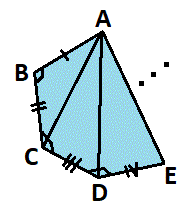Hectogon Congruency Theorem
The minimum number of pairs of sides and interior angles needed to prove two triangles congruent is 3 (by either SSS, SAS, ASA, or AAS congruency theorems).
Find the minimum number of pairs of sides and interior angles needed to prove two 100-gons congruent.
The answer is 197.
This section requires Javascript.
You are seeing this because something didn't load right. We suggest you, (a) try
refreshing the page, (b) enabling javascript if it is disabled on your browser and,
finally, (c)
loading the
non-javascript version of this page
. We're sorry about the hassle.
2 solutions
From one vertex, a 1 0 0 -gon can be split up into 9 8 triangles by 9 7 diagonals. Each of the 9 8 triangles needs at least 3 pairs of angles or sides to be proved congruent, but the 9 7 diagonals that are shared do not need to be counted twice, for a minimum of 3 ⋅ 9 8 − 9 7 = 1 9 7 pairs of angles and sides.
One way to show that this is possible is to start with △ A B C with known ∠ A B C and known sides A B and B C which can be shown congruent by SAS so that ∠ B C A and side A C becomes known by corresponding parts, then add the next triangle △ A C D with known ∠ B C D and side C D which can be shown congruent by SAS again so that ∠ C D A and side C D becomes known by corresponding parts, and so on.

If t n is the number of angles and sides needed and n is the number of sides on the polygon, then t 3 = 3 and t n = t n − 1 + 2 , which can be shown by induction to have the explicit form of t n = 2 n − 3 .
Therefore, when n = 1 0 0 , t n = 2 ⋅ 1 0 0 − 3 = 1 9 7 .
Triangle (3) Square (4) Pentagon (5) n-gon 100-gon 100-gon ⟹ 1 S 2 ( 1 ) AS ⟹ 1 S 2 ( 2 ) AS+AS ⟹ 1 S 2 ( 2 ) AS+AS+AS . . . ⟹ 1 S 2 ( n − 2 ) AS+AS+AS … AS+AS+AS . . . ⟹ 1 S 2 ( 1 0 0 − 2 ) AS+AS+AS … AS+AS+AS ⟹ 1 S 1 9 6 AS+AS+AS … AS+AS+AS
Total elements required Total elements required = 1 + 1 9 6 = 1 9 7